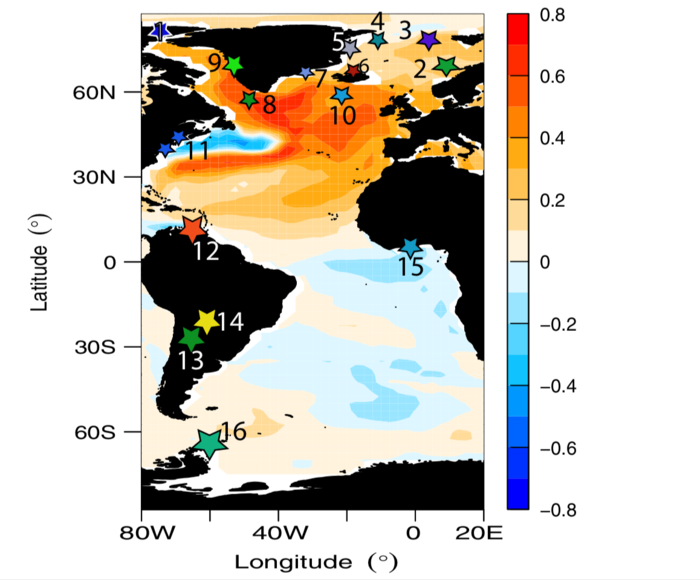Why it happened is one of the persistent questions in historical climatology.
The cold spell set in around 600 years ago and was responsible for crop failures, famines and pandemics throughout Europe, resulting in misery and death. A sudden change from very warm conditions in the late 1300s switched to unprecedented cold conditions only 20 years later.
A new study finds the cooling appears to have been triggered by warming. Using marine records, the authors discovered that there was an abnormally strong northward transfer of warm water in the late 1300s which peaked around 1380. As a result, the waters south of Greenland and the Nordic Seas became much warmer than usual.

Multimodel mean correlation map between the low-frequency AMOC at 26°N and SST (12). Stars numbered 1 to 15 denote location of sites. Image from Lapointe et. al., https://doi.org/10.1126/sciadv.abi8230
Normally, there is always a transfer of warm water from the tropics to the arctic. It’s a well-known process called the Atlantic Meridional Overturning Circulation (AMOC), which is like a planetary conveyor belt. Typically, warm water from the tropics flows north along the coast of Northern Europe, and when it reaches higher latitudes and meets colder arctic waters, it loses heat and becomes denser, causing the water to sink at the bottom of the ocean. This deep-water formation then flows south along the coast of North America and continues on to circulate around the world.
But in the late 1300s, AMOC strengthened significantly, which meant that far more warm water than usual was moving north, which in turn cause rapid arctic ice loss. Over the course of a few decades in the late 1300s and 1400s, vast amounts of ice were flushed out into the North Atlantic, which not only cooled the North Atlantic waters, but also diluted their saltiness, ultimately causing AMOC to collapse. It is this collapse that then triggered a substantial cooling.
Fast-forward to our own time: between the 1960s and 1980s, we have also seen a rapid strengthening of AMOC, which has been linked with persistently high pressure in the atmosphere over Greenland. The authors believe the same atmospheric situation occurred just prior to the Little Ice Age—but what could have set off that persistent high-pressure event in the 1380s?
Look to the trees
They looked to the trees. Once the researchers compared their findings to a new record of solar activity revealed by radiocarbon isotopes preserved in tree rings, they discovered that unusually high solar activity was recorded in the late 1300s. Such solar activity tends to lead to high atmospheric pressure over Greenland.
At the same time, fewer volcanic eruptions were happening on earth, which means that there was less ash in the air. A “cleaner” atmosphere meant that the planet was more responsive to changes in solar output.





Comments